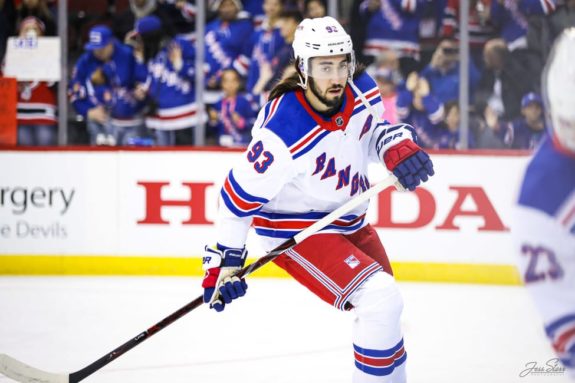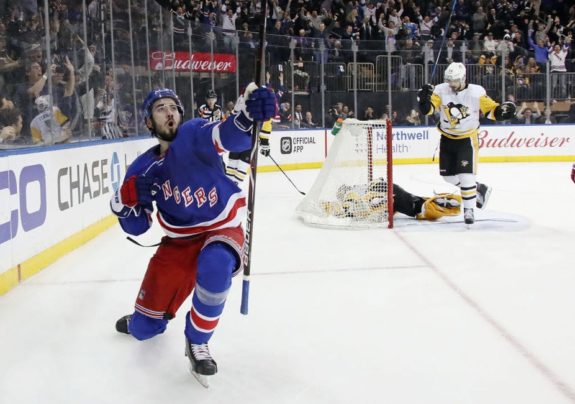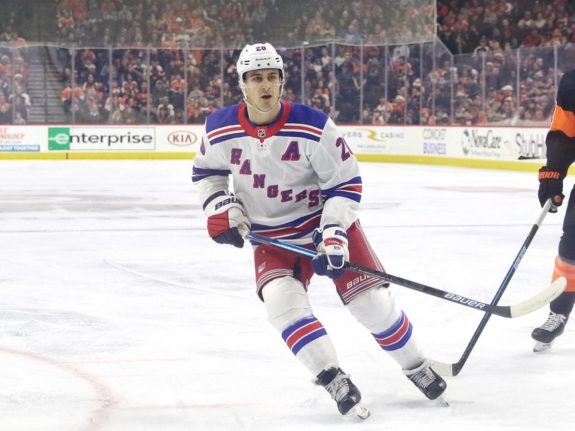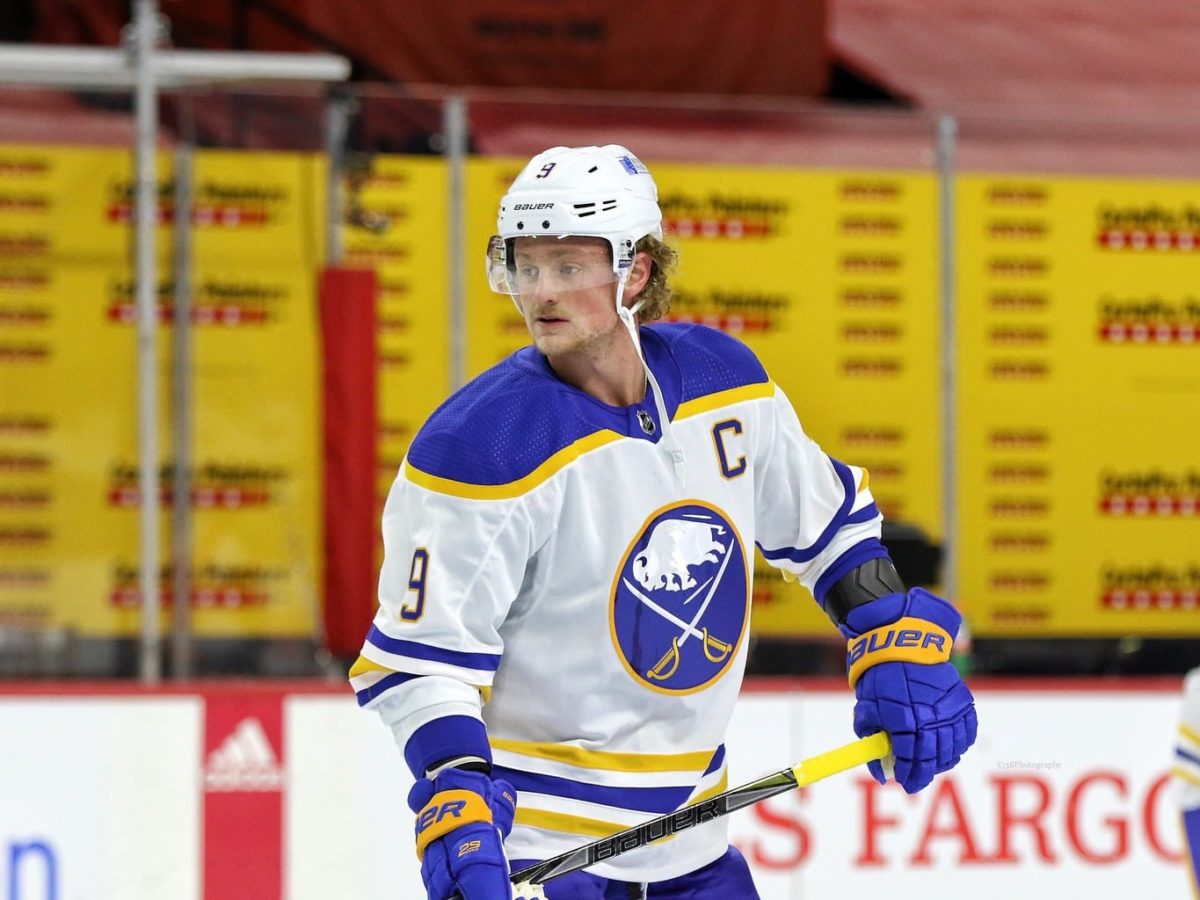Mika Zibanejad was probably the biggest bargain in the NHL over the past four seasons, delivering elite offensive play for a cap hit that came in at perhaps slightly more than half of what players with a comparable body of work make nowadays.
The New York Rangers get one more season of that discount in 2021-22, with the 28-year-old center who recorded 199 points in 195 games over the past three seasons, including 75 in 57 games in 2019-20, playing under a $5.35 million cap hit for 2021-22 before unrestricted free agency arrives next summer.
The Rangers certainly don’t want to lose the player former general manager Jeff Gorton robbed from the Ottawa Senators in a lopsided July 2016 trade that way. Zibanejad has outperformed his contract, and it’s time to lock him up as the No. 1 center – among the rarest of commodities in the NHL – he’s developed into.
Right? Well … maybe.

While the Blueshirts’ new front-office regime led by president and general manager Chris Drury prepares to turn its attention to one of the organization’s biggest priorities, they might want to at least make sure that they are getting an actual top centerman – and all the expectations that come with that distinction.
For there were some at least slightly troubling signs with Zibanejad in 2020-21 that could be chalked up to the abbreviated nature of the season and his preseason illness, yet shouldn’t simply be dismissed either as Drury and co. ponder whether to pay Zibanejad as the long-term anchor of their top forward line.
Some of Zibanejad’s Key Numbers Suffered Worrisome Dips
We’re not talking about Zibanejad’s stunningly slow start, during which he recorded three goals and eight assists in his first 27 games that included a brief in-game benching by ex-coach David Quinn in early March. Zibanejad’s bout with COVID-19, contracted just before training camp opened in January, had a profound impact on his early effectiveness – a fact he finally admitted to shortly after the season concluded last month. His 21 goals and 18 assists over the final 29 contests affirmed that the native of Sweden hadn’t forgotten how to play hockey after his monster 2019-20 season, which included 41 goals.
Yet Zibanejad’s nerve-soothing offensive surge covered up some underlying numbers that the Rangers would do well not to ignore before making the sixth pick in the 2011 Draft one of the highest-paid players in the league.
Perhaps most stark: Zibanejad’s splits. Eighteen of his 50 points – 36 percent – came against the Philadelphia Flyers, whose 201 goals allowed were the most in the NHL. Zibanejad didn’t reach 10 points against any of the Rangers’ other six opponents despite facing each of them eight times, posting his second-highest total of nine against the New Jersey Devils – like the Flyers, a defensively-challenged club that didn’t make the playoffs. His third-highest total, seven, came against the Buffalo Sabres, whose 37 points were the fewest in the league.
The flip side of fattening up on lesser opponents was a disconcerting performance against more formidable outfits: Zibanejad managed three points against the New York Islanders and Pittsburgh Penguins, four against the Boston Bruins and a decent six against the Washington Capitals. That’s 16 points in 32 games against the four playoff teams in the temporary East Division.
His disappearing act against the archrival Islanders – which was hardly limited to Zibanejad as the Rangers went 2-5-1 in the season series – was particularly worrisome. In 2019-20, Zibanejad had two goals and three assists in four matchups to play an instrumental role in the Blueshirts, winning three of those games. The Islanders, a Stanley Cup contender who have built a sustainable program of competitiveness, aren’t going anywhere anytime soon.
If the Rangers are going to give a player an annual salary that could approach or exceed $9 million per season, they’ll want a star who’s at his best in big games – not someone who just pads his stats against lesser teams. While it’s again just one season, the Rangers better hope Zibanejad’s numbers against tougher competition don’t mark the beginning of what would be a troubling trend.

His 2020-21 splits, though, aren’t the only numbers the Rangers should look at closely. A glance at Zibanejad’s advanced stats don’t paint a pretty picture, either. First and foremost was his Corsi For percentage (CF%) of 45.6, a career-low for a full season and a nearly five-point drop from 2019-20. That effort pushed his career CF% below 50, to 49.3.
Zibanejad’s Expected Goal For Percentage (xGF%) was equally ugly, at 45.24, and the Rangers generated 101 High Danger Chances For to 137 Against when he was on the ice, a 42.44 mark.
Is Zibanejad’s Game Becoming Too One-Dimensional?
While advanced analytics don’t present a complete picture of a player, and certainly don’t override Zibanejad’s oversized offensive production, there’s enough here to suggest he isn’t consistently driving possession for his team – and more importantly, could be trending down in that department. Zibanejad’s High Danger Scoring Chances For % (HDCF%) in 2019-20 was 45.4, certainly not good, and that number continued to head south this season.
A more traditional number, faceoff win percentage, also suffered an alarming drop. Zibanejad won at least 49.1 percent of his draws for six straight seasons coming into 2020-21, yet that number dipped to 46.3 this season. That’s not close to acceptable for someone who wants to be paid as a No. 1 center – the player whom a coach needs to be able to count on at the dot in big situations.
Finally, Zibanejad’s shooting percentage during his career season of 2019-20 was 19.7 – more than six points better than his previous best and tied for third among players who played at least 50 games. While he posted the second-best number of his career last season at 14.0, it marked a predictable correction toward his career average of 13.0.

Zibanejad converted on 12.7 percent of his shots in 2018-19 and did record 74 points, one shy of his total for the following season, but scored 11 fewer goals than he ended up getting in 2019-20. Given the apparently outlying 19.7 shooting percentage of two seasons ago, does that paint his 41-goal season as an outlier as well? Forty-goal seasons could become the norm for Zibanejad, but that could also prove to be a dangerous assumption, particularly as he ages. Can the Rangers expect the 2019-20 version of the player to stick around through a long-term contract, with this past season the one to disregard due to his COVID battle, or is he something in between the two campaigns?
The concern, if the Rangers have any at all, is that they could be committing star money to a player, who might be on his way to doing one thing very well, yet lacks in critical other areas. While hardly a perfect comparison, the Blueshirts already have one such player on their roster in Chris Kreider.
The power winger, signed to a lucrative seven-year extension just before the 2020 trade deadline, looked like a specialist of sorts this season: He excelled in front of the net and on the power play, using his size, positioning and exceptional ability to redirect shots from in front to score 11 times with the man advantage. Yet Kreider scored only nine other goals on the season, and his open-ice game, once so lethal and intimidating as he bore down on opposing goaltenders on the rush, was mostly absent – surely not what Gorton envisioned when he blinked and agreed to a contract that carries a yearly $6.5 million cap hit.

Is that how Zibanejad will look in Year 3 or 4 of a new deal? In his case, perhaps someone who piles up the points against lesser teams, like when he recorded back-to-back three-goal, three-assist efforts against the Flyers in March – only to disappear in tougher matchups? Though it might be gratuitous, it’s worth pointing out that those performances came against a Philadelphia team that seemed to have quit both times, as the Rangers outscored the Flyers 17-3.
Zibanejad’s offensive game has been on a mostly meteoric rise the past three seasons. The Rangers should want to see upward mobility in all key facets of his game if they’re to commit the really big bucks.
Potential Trade for Star Center Could Affect Zibanejad’s Status With Rangers
Regardless of whether his advanced numbers come up and his faceoff percentage rebounds, do the Rangers – so thin in the middle – really have any choice but to offer Zibanejad a long-term contract? Actually, they might. Should Drury pull off a blockbuster trade for a star center such as Jack Eichel or Alexander Barkov this summer, the Rangers would have insurance and leverage in their negotiations with Zibanejad. That might allow them to move on from him after next season and potentially follow a more cost-effective path down the middle, rather than carrying two mega-contracts for centers going forward.
Latest Rangers Content:
- New York Rangers’ 4 Best Contracts for 2024-25
- Rangers Need Miller/Schneider Pair to Take Big Step in 2024-25
- A Hockey Fan’s Travel Guide to New York City
- Rangers’ Zibanejad Must Prove Doubters Wrong With Bounce Back in 2024-25
- 9 NHL Teams That Missed in Free Agency
Even if they do swing a deal for Eichel or someone else, though, does the club want to give up on a player it acquired for a song who was among the top offensive forces in the NHL in 2019-20 – scoring five times in a 6-5 overtime victory over Washington in March 2019? When he’s on, Zibanejad makes scoring goals and piling up assists look easy – and with the exception of his slow start this season, he’s been mostly on for the past three years. Eichel and Zibanejad would give the Rangers quite the 1-2 punch down the middle and the building blocks of two formidable top forward lines that would make defensive matchups very difficult.

Chances are that Drury is planning on offering Zibanejad a big contract at some point this offseason or at the latest, before next season’s trade deadline. However, the new GM, known as an analytical, thoughtful person, might want to procure a larger sample size of some of the numbers mentioned above and watch how he performs for at least part of next season before taking the big-money plunge. If those key metrics continue to trend downward and Zibanejad is again less than effective against better opponents, Drury will have only himself to blame if the Rangers get less than they bargained for with a huge extension.